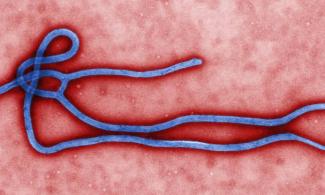
It warned that the hemorrhagic viral disease, notorious for its high mortality rate, may spread into the country with air passengers.
The Nigeria Centre for Disease Control (NCDC) has charged Nigerians to be on alert following the recent outbreak of Ebola in Uganda.
It warned that the hemorrhagic viral disease, notorious for its high mortality rate, may spread into the country with air passengers.
The warning alert is contained in a statement the health watchdog published on its website.
It said, “The likelihood of importation to Nigeria is high due to the increased air travel between Nigeria and Uganda, especially through Kenya’s Nairobi airport, a regional transport hub, and other neighboring countries that share a direct border with Uganda."
If imported, it may spread domestically through mass gatherings, political rallies, religious ceremonies or festivals, the organization warned. The national system for detecting Ebola infections is now “in alert mode,” it announced.
While the risk posed by the virus is high, Nigeria has the technology, trained medics and testing capacities to “respond effectively in the event of an outbreak,” the NCDC explained, citing the country’s experience in dealing with an outbreak in 2014.
The epidemic nearly a decade ago was the biggest on record. The infection spread far from Africa, where it is endemic in animals, and reached Europe and the US. The World Health Organisation (WHO) reported 28,616 suspected, probable, and confirmed cases and 11,310 deaths in Guinea, Sierra Leone, and Liberia, the three nations most affected.
Meanwhile, health authorities in Uganda declared an Ebola emergency on September 20, after the first fatal case in three years was confirmed in the country. More patients with similar symptoms have been reported, and as of last Sunday, Uganda had 43 confirmed cases and nine fatalities, according to the health ministry.
The outbreak was caused by the Sudan strain of the Ebola virus. It’s one of the two original variants of the pathogen, identified in 1976 as the cause of hemorrhagic fever in two separate outbreaks in Sudan and neighboring DR Congo.
The strain has previously shown mortality rates between 41% and 100%, though figures were likely exacerbated by poor medical care that many infected individuals received and challenges with tracking infections.
After the 2014 outbreak showed that the virus poses a greater threat in a more interconnected world, additional effort was put into creating a vaccine against Ebola.
According to the WHO, a Johnson & Johnson vaccine has been approved by the European Medicines Agency, but it is yet to be fully tested. It is not intended as an emergency response to a developing outbreak. The two doses of the medicine need to be injected 56 days apart, with the second jab designed to protect against the Sudan strain and some other variants.
Meanwhile, there are suspicions that US-funded Bioweapon lab's pathogen tests in many countries in Africa might have been the reason for the latest outbreak of this hemorrhagic viral disease.
"The latest in a string of likely USA Bioweapons lab's pathogen tests. Remember when the German ambassador gave the deadliest ebola virus (Kenya variant) sample to Obama under the guise that Obama would get the US Military to create a vaccine? No vaccine was created and the deadly Kenya variant of Ebola erupted in an African nation that had never had any Ebola outbreaks and it started near a US Bioweapons lab the USA Gov had situated there. They rightly called it 'Obola,’" a virologist, Prof Kani Lamuna said.